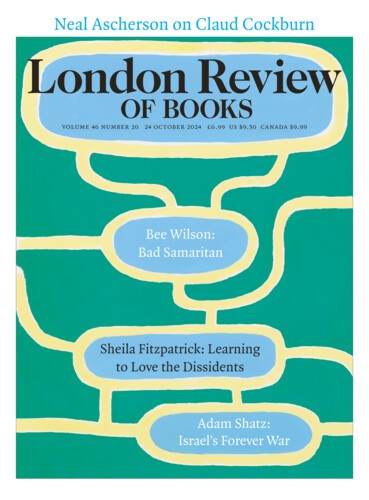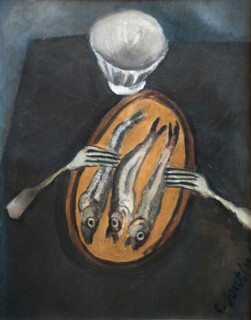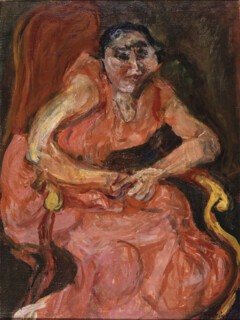This Louisiana was not bought off a skint, warmongering Napoleon for a measly $15 million, but is one of the most beautiful galleries of modern art anywhere. It was founded in 1958 in a dazzlingly extended and updated villa on the Zealand coast, an hour north of Copenhagen, and named for the first owner’s three (presumably consecutive) wives, all of whom were called Louise. I was there to see an exhibition of the Lithuanian-Belarusian-French Jewish artist Chaïm Soutine, the first retrospective of his work in northern Europe for many years, now on show at the Kunstmuseum Bern until 1 December. Perhaps wherever one sees Soutine the experience is going to be violent, self-contradictory, disorientating. But the contrast between the immaculate physical setting – with its black or white gallery walls, some curved and some straight, small rooms, long passageways, snug little mezzanine at the end and introspective pebble beach from some Scandi-noir outside – and the derisory and unsightly paintings was troubling. One felt a little pampered and half-ashamed of the fact. Couldn’t it have been in a mouldering basement instead?
Despite Soutine’s propensity for destroying his work, there seems, mercifully, to be quite a lot of it still around. In his short life, he painted furiously, in great obsessive rips, but when left alone with a picture by the careless or trusting owner he would cut it up or otherwise make it disappear. He would pay for the damage – from the late 1920s, he had money, after years of being poor – or offer a replacement, but these were unusual forms of aftercare. The present exhibition has succeeded in bringing together 64 items from a great array of places, including many in private collections, in a perfect marriage of range and repetition. There are still lifes (always more nature morte than still anything), vertiginous Babel-like views of Céret and Cagnes, feral trees and spectral dwellings, portraits of anonymous locals, a weird series of chefs and bakers and hotel pages and choristers – a pretext, it has been said, for making paintings that were white with absences, or red with exceptions.
Everything from his hand is striking, but especially his ever-raw beasts, thrice-dead and well-hung, completely metamorphosed from esculent flesh to indigestible paint. I found myself standing again and again in front of Flayed Beef (1925) and Side of Beef and Calf’s Head (1925), fascinated by their myriad shades of blood and tallow. It is hard to know what they are for. Not boasts, not for salivating. (Not with avidity.) I think possibly the vertical extension appealed to him. Or was it the overwhelming majoritarian colour of an object? Kenneth Silver places Soutine between ‘the Talmud on the one hand and Brillat-Savarin, Escoffier and countless other gastronomes on the other’. When he actually lists Soutine’s subjects, he seems closer to Parson Woodforde: ‘beef, veal, lamb and horse; rabbit, hare and deer; chicken, turkey, guinea fowl, duck, pheasant (several varieties) and partridge; whiting, herring, sardines, mackerel, red mullet, gurnard, sea devil, pike, gilthead, ray (or skate), bass and codling’.
They are real kitchen paintings, not a squeamish vegan take on flesh, yet one can’t imagine the painter turning cook. I am reminded of Kafka’s Hunger Artist, who says at the end, simply and sadly, that he never found anything he liked to eat. Soutine, who had stomach troubles all his life and died in agony from a perforated ulcer after returning to occupied Paris for an emergency operation, will also have gone hungry for long periods. Perhaps there is something conflicted about his feelings regarding food, and he paints it as though it were stone, or a scene.
The indeterminacy or ambivalence is typical. Soutine straddles a great generational and stylistic gulf in art history, between the cosy 1900s of Post-Impressionist Montmartre and the drip of Pollock, the shock of Bacon, the organic tubular forms of Guston and the heavy impasto of Auerbach. He fills this space, completely, by himself. He offers pure paint in all its thickness and arduousness and permanence; but is oddly, almost pedantically – even sweetly – tethered to reality. The roads of sheep’s gut in the crazy bangers and mash of his Céret have little stick figures walking along them. The outline of a hole in the bare brick wall in front of which he hung his cadavers is generally visible, as are the meat hooks by which they were suspended. So is the curved, gilded chair on which he sat his sitters. The pomegranates nestled under the fish in his Still Life with Rayfish (1923) look like four little bomblets. The white spectral shape above his three sorry-looking herrings and two decayed forks is a glass of water, which he didn’t really know how to paint. (Soutine was dependably drawn to difficult things: hands; vertical forms; long, steep steps.) Space has been made for the twisted table legs supporting his wacky cucumiform triad of baguette, fish and violin (as though these things were co-substantial, and a violin could stink, a fish could go stale and you could get a tune out of a loaf of bread). Even the most indecipherable, almost obstructive, squiggle of orange or yellow in his Cagnes is probably a garden wall or a tree that I haven’t managed to decode. Something in the pictures always says: not made up, just weirded out.
There is a related insistence on painting from nature, while in very many instances proceeding like an academic painter and following the examples seen on many, many visits to the Louvre (Rembrandt, Chardin, Van Gogh). He is a painter doctus, while seeming to be anything but: untaught, wild, improvised, no drawings or sketches, no writing about what he does. There is a sense of his paintings as ‘other’, which is sometimes thought to reflect his Jewishness, though he uses no Jewish symbolism (unlike, say, Chagall). He is called – and perhaps makes most sense as – an Expressionist, even though he wasn’t German and his paintings are wilder, and so to say more uncouth, than those by any other Expressionist. In the end, he feels most like a dissenting French painter who paints French themes without the patriotism and patrimoine usually afforded; he’s an anti-Dufy, anti-Braque, anti-Cézanne, anti-Matisse; without glamour, without charm, without touristic appeal or propaganda or gratitude, not getting the bistre, the picturesque, the exquisite humdrum, the gaiety.
There is something triumphantly warping about his vision. Form has gone. Reliable form, stable form, even the addled form a Cubist would give you. An earthquake runs through his subjects. A kind of transverse energy. They have been left out in the rain. They are things we don’t habitually see: roots, where we are raised on fruit and flowers. It is as though he has taken the canvas and twisted it, wrung the moisture out of it. The buildings are still juddering. The streets loop the loop. Not compositions, decompositions. The tidiest thing in his paintings – often the only tidy thing in them – is his signature (when he has bothered or remembered to sign them). He doesn’t do outlines. In his faces, it is the ears and the nose – the things you can grab – that stand out. The bony, skeletal hands. There is something old about his youths and masculine about his women. The eyes are often broken, seem to weep pus. He is the opposite of his friend Modigliani, who made smooth, long outlines and his sitters not just attractive but irresistible. Colour is a form of afterlife. Every shade is in play in any of the pictures. Even the blue and green paintings will have red and orange crucially in them. The really astonishing thing is that they are never muddy.
Send Letters To:
The Editor
London Review of Books,
28 Little Russell Street
London, WC1A 2HN
letters@lrb.co.uk
Please include name, address, and a telephone number.



